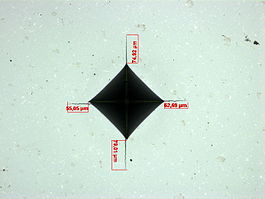| Materials testing | |
|---|---|
| Palmqvist method | |
 Determined crack lengths from a Vickers indention. | |
| Technical information | |
| Searched property | Fracture toughness |
| Year developed | 1962 |
| Practical use | Determination of the fracture toughness for cemented carbides. |
| Website ISO-standard | ISO 28079:2009, Palmqvist toughness test |
The Palmqvist method, or the Palmqvist toughness test, (after Sven Robert Palmqvist) is a common method to determine the fracture toughness for cemented carbides. In this case, the material's fracture toughness is given by the critical stress intensity factor KIc.
Approach
The Palmqvist-method uses the lengths of the cracks from a number of Vickers indentions to determine the fracture toughness. The Palmqvist fracture toughness is given by
- in units of MPa,
where HV is the Vickers hardness in N/mm (or MPa) (i.e., 9.81 x numerical HV), P is the indentation load in N (typically 30 kgf is used) and T is the total crack length (mm) after application of the indenter.
Notes
- S. Palmqvist, Occurrence of crack formation during Vickers indentation as a measure of the toughness of hard materials, Arch Eisenhuettenwes, 33 (1962) 629-333.
- ^ Roebuck, Bryan; Bennett, Eric; Lay, Lewis; Morrell, Roger (2008). "Palmqvist Toughness for Hard and Brittle Materials" (PDF). National Physical Laboratory. Retrieved 15 April 2020.
 in units of MPa
in units of MPa ,
,